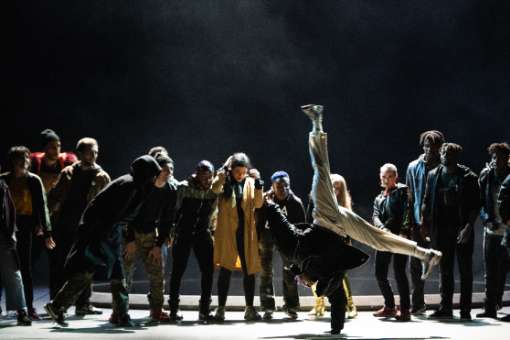Without a doubt, Les Indes galantes is the French classical opera which comes closest to the ideal of the genre, in which all the arts are in service of the extraordinary. After the mythology of Hippolyte et Aricie and before the supernatural of Dardanus, Rameau concentrates on depicting natural phenomena, a main focus of study in the age of the Enlightenment. A volcanic eruption, a thunderstorm, a tidal wave, the exoticism of faraway lands… what a wonderful playground for the first of the great symphonists!

This particular artistic intent, where the spectacular blends into a galant and stripped-down representation of feelings, can be a challenge for a contemporary director. Clément Cogitore moves the imaginary fairyland into the gloom of cities where the eye gets lost into eerie, blueish half-shadows where for a moment we might fear monotony. Yet the familiar traditional elements (the circle of fire) or the impersonal technology (LED panels representing the sun and an enormous articulated arm lifting the ship after the storm) create and challenge the natural cataclysms and frame the action. A central circle can be transformed, depending onto the scene, into a volcano, a rotunda or a chasm or hollow: it’s an elegant and understated solution.
The general streetwear and hoodies feel of the costumes could have made one fear the worst, but when the technically virtuosic dance starts up (impressive krumping from the Savages or very humourous voguing in the act with the generous Turk) it becomes clear that the energy is in tune with the nature of the music; hence we forget about the dreary fabrics. Choreographer Bintou Dembélé and the dance company Rualité are able to find a language well suited to Rameau’s energetic accents, such as in Phani’s air, “Viens hymen“, where dancer, flute and the translucent voice of Sabine Devieilhe reveal countless subtleties. The strength of the warriors in the prologue and of the conquistadors in the second entry is highlighted with Robocop riot police costumes, a straightforward but fun idea that lets the audience make up its own mind as to interpretation without ruining the enjoyment of the music. In the flowers act, transported into the Amsterdam Red Light District, the singers gather on a small islet of some three square metres: the lack of dialogue, as it is in the libretto, once again leaves space to Rameau’s language.
As for the singers, there’s nothing negative to say, apart from a slight doubt as to the compatibility of singers with their roles. Florian Sempey and Alexandre Duhamel sang an octave higher or avoided the lowest notes of Bellone and Huascar, but inhabited their characters masterfully. Stanislas de Barbeyrac is without a doubt a perfect Ottavio for Mozart, but his heroic voice enlarges in an exaggerated way the soft lines created for haute-contre singers in the French tradition. although his psychological interpretation is charming. On the contrary, Mathias Vidal is ideal in the lively ornamentation of Tacmas, but the support and intonation are in danger in his Valère, with a decidedly fragmented line, and in the beautiful Flower Quartet. Edwin Crossley-Mercer is his usual self, the splendid sheen of his voice contrasting with a somewhat conventional musical involvement.
The female cast is, quite frankly, astounding. From the time of her collaboration with Alexis Kossenko, Sabine Devieilhe knows Rameau like the back of her hand: her voice is delightful, the middle register ever more seductive and the phrasing absolutely fascinating. Jodie Devos portrays an Amour and a Zaïre that can move between authority and the most moving fragility, and Julie Fuchs brings to Fatime a superlative roundness of tone, albeit remaining slightly in the background during the storm scene.
But the main architect of the success of this evening is without doubt Leonardo Garcia Alarcón, who draws an extraordinary palette of colours from his orchestra. Entrusting this challenging music to a conductor gifted with true technique allows its genius to shine through even in to the most decorated pages. He communicates admirably, does not stop the orchestra from playing, like many others do, and sees the big picture. The overture, perfectly detailed and already “exotic”, the elegance and density of the minuets, the prevailing flexible inequality outline a Rameau more eloquent than ever. One notices a particular care in the phrasing of the basses and in the construction of the harmony. Alarcón deploys an expressiveness previously unseen, particularly in the instrumental preludes, where the sophistication is exceptional.
The instrumentation has been cleverly expanded in service of this rich vocabulary. We can turn a blind eye to a number of historically inaccurate choices such as violas or guitars, or the cuts that make Osman’s psychological U-turn incomprehensible, or the addition of Rameau pastiches composed by the conductor… Tonight, the truth is in the beauty. For this unforgettable evening, the Chœur de chambre de Namur have without a doubt presented the most moving version ever of the choral piece “Clair flambeau”, and their generosity of timbre in the admirable “Traversez les plus vastes mers” melted admirably into the sound of the orchestra.
This review was translated from French by Laura Volpi.


